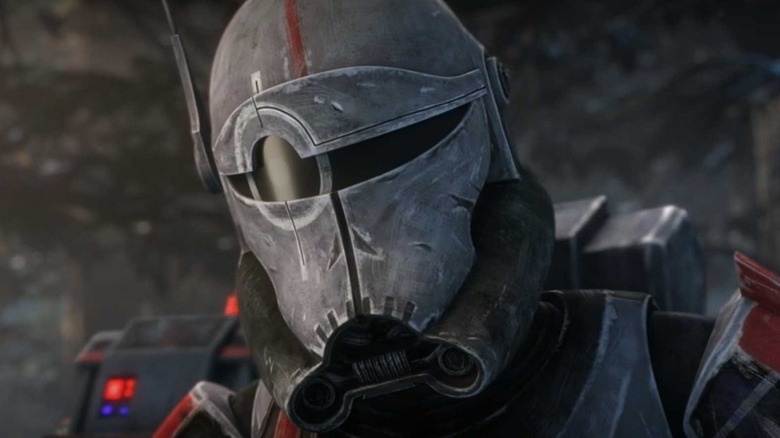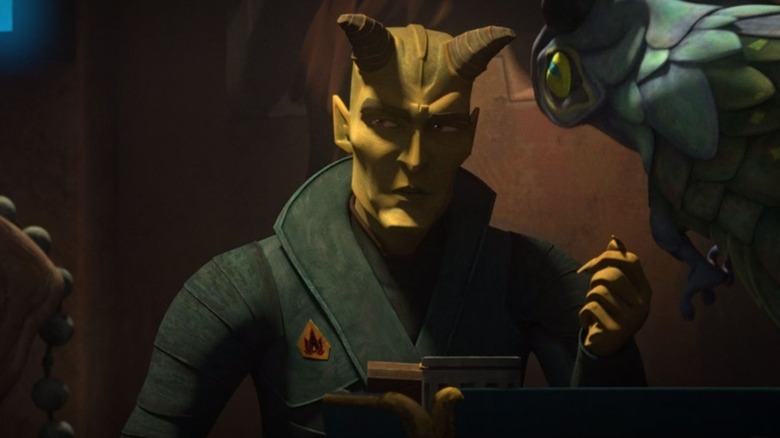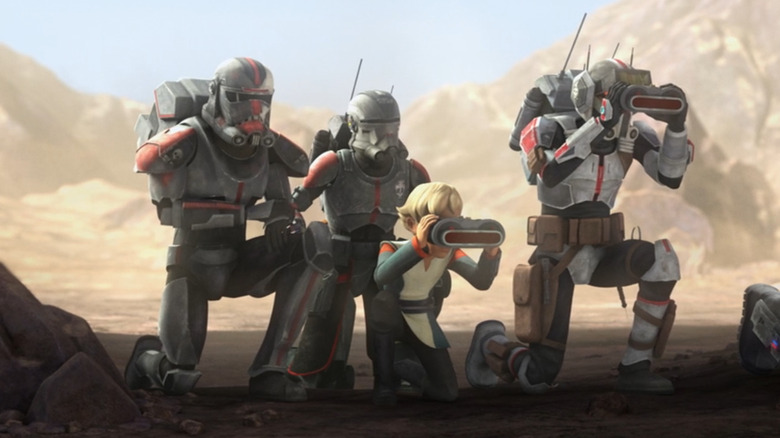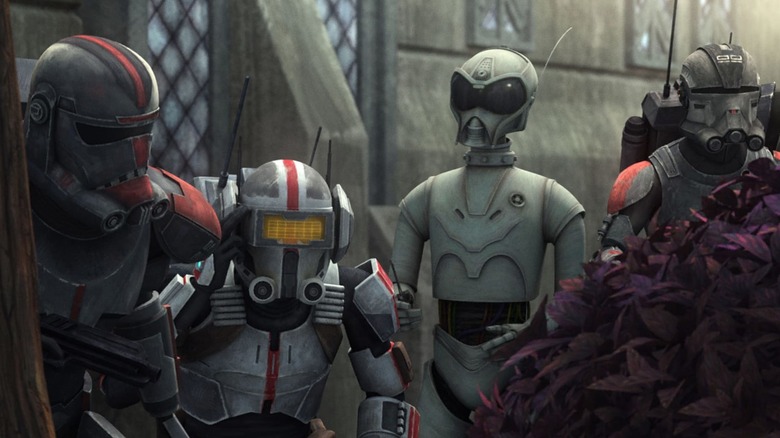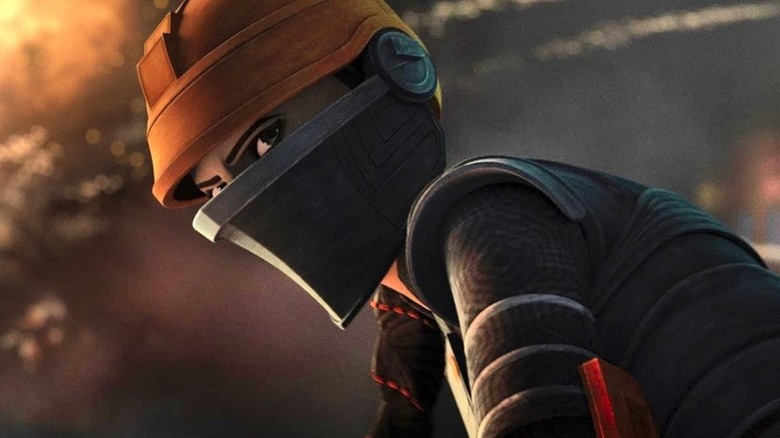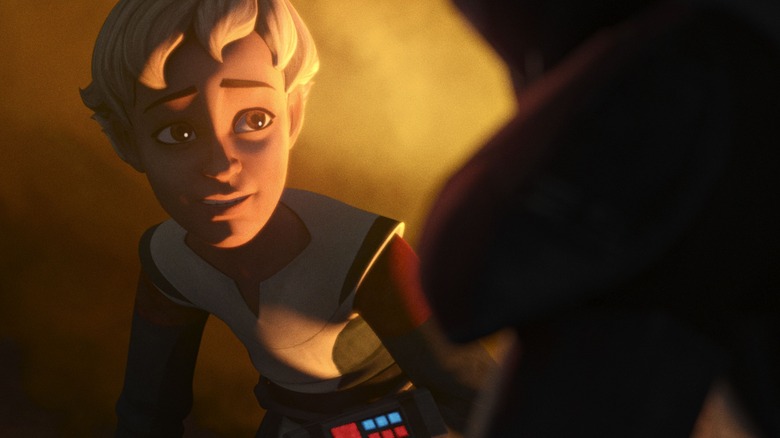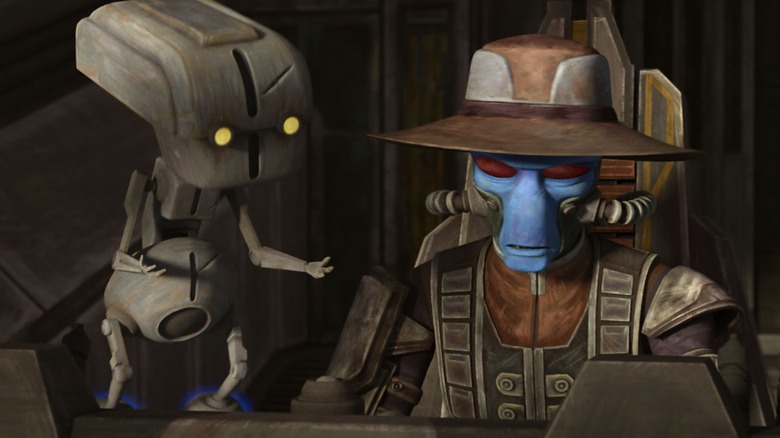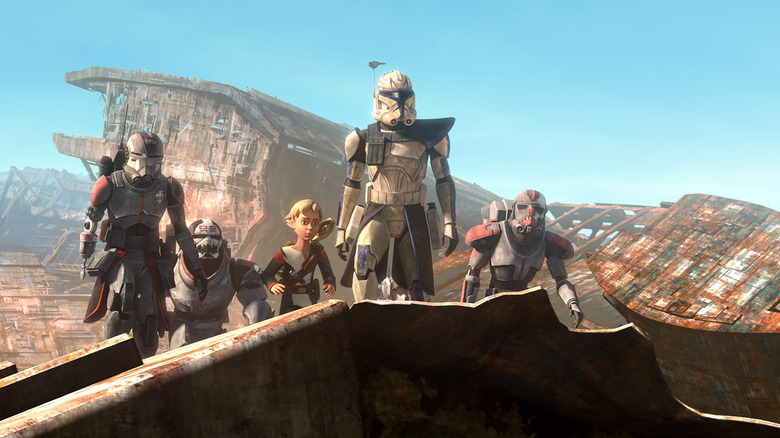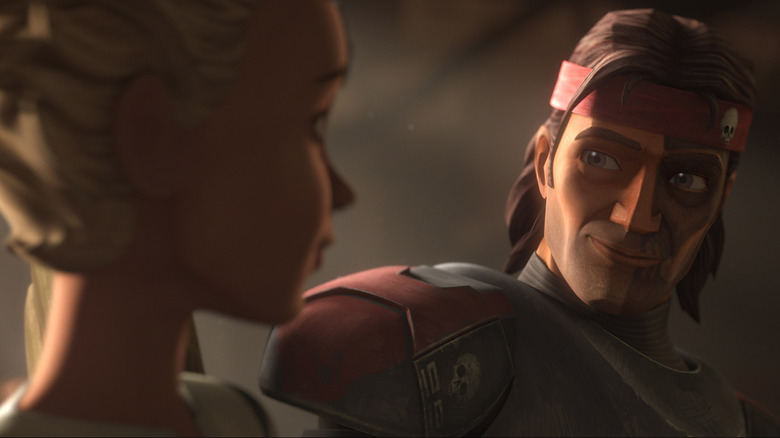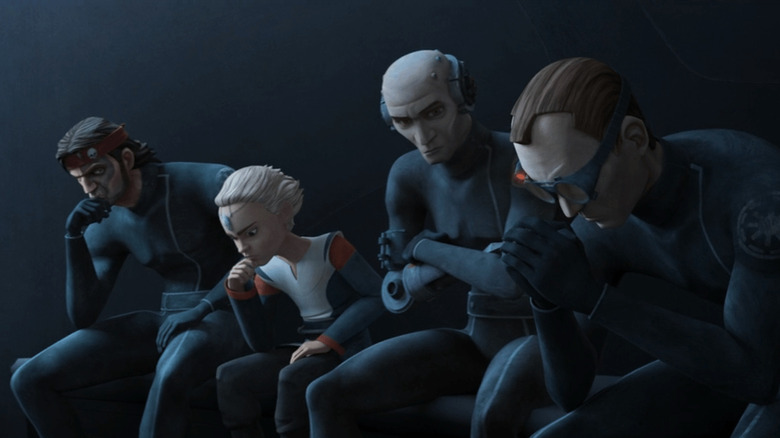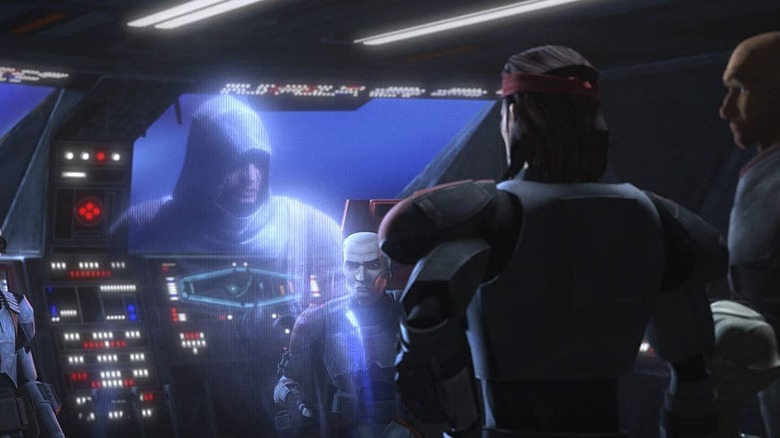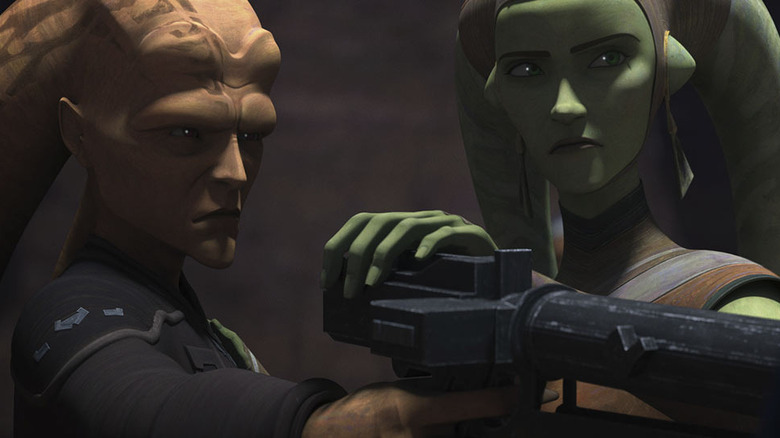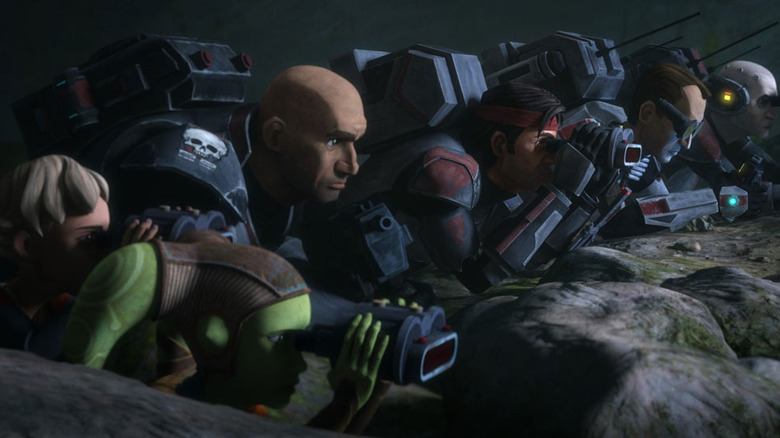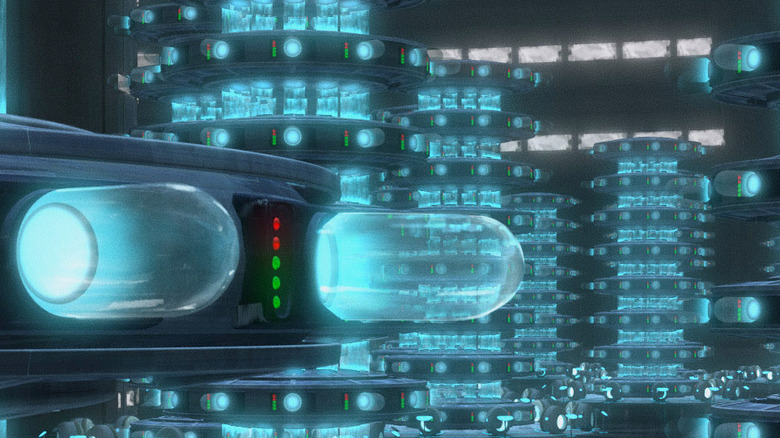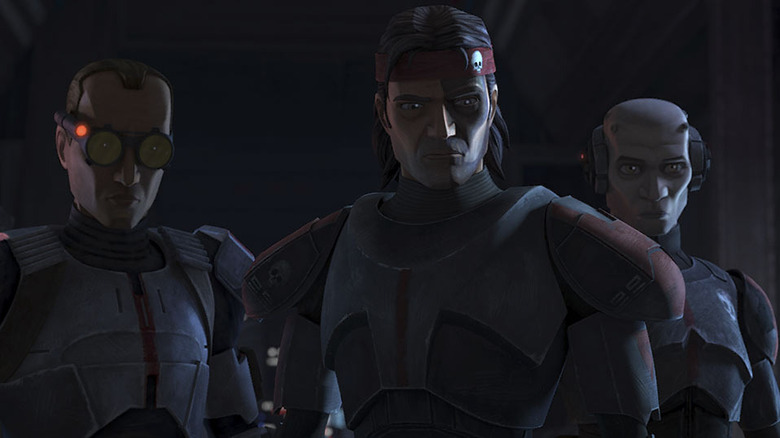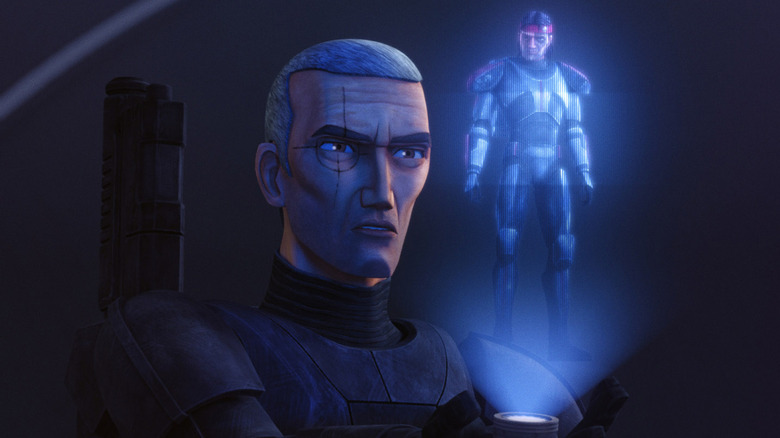Ranking Star Wars: The Bad Batch Season 1 Episodes From Worst To Best
The members of the Bad Batch, also known as Clone Force 99, are not like the other clone soldiers of the Star Wars prequel era. Introduced back in the final season of "Star Wars: The Clone Wars" and all voiced by Dee Bradley Baker, they're an elite squad of clones with genetic mutations. They have the same Jango Fett DNA as regular clone soldiers ("the regs"), but possess special qualities as well. Their leader, Hunter, senses electromagnetic fields. Wrecker is brutishly muscular. Crosshair has the enhanced sight of a sharpshooter, Tech is a whiz with machines, and Echo (the only "non-mutant" in the group) lives with a cybernetic body due to Separatist abuse.
The rise of the Galactic Empire radically rearranges the Bad Batch's world, leading the soldiers to defect — most of them, anyway. To the Bad Batch's dismay, Crosshair stays with the Empire. The rest of the brothers flee and adopt Omega (Michelle Ang), an adolescent Kamino medical assistant who turns out to be a fellow clone.
Released on Disney+ as both a spin-off and sequel to "The Clone Wars," "The Bad Batch" explores a time period that has long been a point of curiosity to Star Wars fans: the early days of the Emperor's reign. Here are all 16 episodes of the first season of "The Bad Batch," ranked from worst to best.
15. Infested
Filler is never a bad thing. Filler can flesh out characters and offer new insights on the world. "The Mandalorian" and "Star Wars Rebels" both have their share of filler episodes that shine on a re-watch. But "Infested" isn't on their level. It's a lighthearted interlude intended to give the crew some breathing space before a drastic turn in the following "War-Mantle," but actually watching it, it's a dud.
The Bad Batch discovers that its employer, Cid, has been usurped by a young and upcoming crime boss. At Cid's behest, the Batch travel through a hidden tunnel to steal the crime boss' spice shipment and ruin his deal with the Pyke Syndicate. Problems arise when they disturb a slumbering swarm; in addition, the Pyke Syndicate is not happy about their intervention.
At least "Infested" has a self-contained conflict. Amusing stuff happens, and voice actors Rhea Pearlman and Dee Bradley Baker play well off each other, but the dialogue is mostly uninspired scolding. The only thing that feels important is the normally apathetic Cid showing genuine emotion for Omega and becoming warmer to her employees. But other than a trek over an abyss, a swarm of bugs, and the introduction of some criminals who could become recurring characters, not much happens here.
14. Rampage
The boys land on Ord Martell to find an informant who could help ascertain the identity of the bounty hunter who's after Omega. The informant, Cid, cuts a deal out with them: rescue a "kid" that turns out to be a stolen rancor in return for information and employment.
It's the Bad Batch's first mercenary mission of the series, and it's a pretty average one. Omega learns that slavery exists and finds her energy crossbow. Echo briefly contends with the fact that they're doing a mission for money, not innate heroism. "Rampage" also illustrates Hunter and Omega's adaptability following their close call with Fennec Shand. Omega learns her lessons about stranger danger and reluctantly follows Hunter's order to stay on the ship, only rejoining her brothers when her situation becomes precarious.
While little touches that reinforce the team's long-term dynamics, "Rampage" is a self-contained mission that mostly amounts to a piece of fanservice. Sure, it might be nice for Star Wars fans to see a rancor taken to Jabba's palace (although it's not the same rancor from "Return of the Jedi"). But what else?
13. Common Ground
"Common Ground" is far from a bad episode, but fails to live up to its promise. In a departure for the series, "Common Ground" points the camera not at the clone brothers, but instead at a planetary-wide political situation: first, a crowd shot of oppressed Separatists and a worried Separatist senator. When the senator defies the Empire to raise his people's morale, he is arrested. His droid sends a memo to Cid, asking for extraction. It's a premise full of potential: the clones are assigned to free a Separatist despite their past fighting Separatists. Naturally, Echo, who was tortured by Separatists, is infuriated.
"Common Ground" explores the Empire's grip on the Separatists. But, although the clones successfully perform the rescue, they don't face much meaningful change. Other than fighting alongside a Separatist, their perspective isn't really challenged, and they don't grapple with the larger moral implications of their actions. Echo acknowledging that the senator must stay alive to fight is barely earned.
The opening of "Common Ground" does sneakily prepare the audience for a drastic shift, which comes in the next episode, and which begins on a similarly agitated crowd shot on a Republic-allied planet only to lead to a very different result.
12. Cornered
"Cornered" marks the chronological debut of "The Mandalorian" star Fennec Shand, played again by Ming-Na Wen. After living a sheltered life on Kamino, Omega has already realized that terrible creatures with pointy teeth will gobble her up, as seen in "Cut and Run." But in "Cornered," Omega learns the hard way that nice strangers aren't always what they seem. While her brothers gather supplies and fix their ship, Omega happily explores the populated market stalls of Pantora. However, she gets lost. A lady seems to be willing to help her — only this lady is Fennec, who's after the bounty on Omega.
Whether or not the viewer is already acquainted with Fennec, who's going to co-star alongside Boba Fett in "The Book of Boba Fett," the episode shows off her competency as an antagonist. Fennec's presence sparks a chase throughout Pantora, forcing Omega to rely on her instincts and her brothers' skills to survive.
11. Decommissioned
"Decommissioned" juggles plenty of drama, character growth, and impending fears. Omega adjusts to her new energy crossbow. The Martez sisters return from "The Clone Wars." Wrecker suffers a secret breakdown, signifying that his brain chip is activating. The Bad Batch throws away a mercenary assignment that violates its morals.
Cid tasks the boys with gathering intel from a droid's head at a smelting facility on Corellia. What appears to be a straightforward mission is complicated when it turns out two strangers, the Martez sisters, are also after the droid — although, the Batch discovers, they have noble reasons to look for it.
These encounters propel the brothers into uncharted territory. The action hurls them into helter-skelter chaos, locking them in a dire situation in which they reluctantly make allies without knowing their motives. By the time the Bad Batch is done and out of the facility, the clones and the sisters are on happier terms. Still, some resolutions feel too convenient, like Omega's quick mastery of her crossbow and Hunter not hesitating to hand the intel to the Martez siblings.
10. Bounty Lost
With her brothers in hot pursuit, Omega must figure out how to escape from the clutches of bounty hunter Cad Bane, who is en route to an abandoned Kamino facility to trade the girl for credits. This opening gives Omega too easy of a way out: playing to the needs of Cad's half-competent sidekick robot, Todo, so that he frees her.
But the rest of the episode demonstrates the little girl's competency as a child who is still trying to understand the galaxy. As she dashes through lab corridors, she sees ghastly mummified corpses in experimental vats — it's then that she learns what terrible fate will be for her in store if she's dragged back to Kamino.
Other than a showdown between the wily Fennec Shand and the veteran gunslinger Cad Bane, "Bounty Lost" is mainly a wake up call for Omega, helping her understand the stakes of returning to Kamino, where she'll be little more than an unlucky experiment.
9. Battle Scars
Now that their old pal Rex knows that the Bad Batch are lurking on Ord Mantell, the clones reunite in Cid's parlor. Rex is incensed to learn that the members of Clone Force 99 have not removed the chips in their brains, which could activate at any moment and force them to carry out Order 66.
After a series of head injuries, Wrecker's chip is on the brink of activation. Rex takes his crew to a derelict Republic ship to use a surgical machine to remove their chips. But, as they load an agitated Wrecker onto the convoy, the team's heavy transforms into a soulless, merciless brute who storms down the corridors to execute his brothers and his beloved little sister, Omega. It takes wits and muscles to drag Wrecker back to the medical chamber.
The bond between Omega and Wrecker is the heart of this episode. While it's not a pointless chapter, and continues disturbing developments that run across the season, "Battle Scars" mostly sees "The Bad Batch" find a convenient way out of a corundum, as every single member of the Bad Batch has their brain chips removed by the end.
8. Cut and Run
"Cut and Run" marks the return of clone deserter Cut Lawquane and his family. From his first appearance in the "Clone Wars," Cut represented a mode of living that was denied to clone soldiers. Here, we learn that Cut is secretly friends with pariahs like Clone Force 99. However, the Empire's influence is growing, complicating the Lawquane' escape from their home.
Cut's relatively idyllic life serves as a great example to the Bad Batch, who have just adopted a child of their own. Still learning the ways of the galaxy, Omega gets into trouble when she wanders too far and is nearly eaten by a creature, much to her guilt. Cut and his wife, Suu, instruct Hunter to be as nurturing as possible to Omega. Hunter, thinking he can't provide what Omega needs, decides to send Omega away with the Lawquanes. But in the end, Clone Force 99 is Omega's chosen family.
"Cut and Run" takes a look at civilian life, and how it changes in the Empire's presence. It's a turning point for Hunter and the rest, showing them settling into their roles as Omega's guardians as she learns how to be part of the squad.
7. Aftermath
The 70-minute pilot episode of "The Bad Batch," "Aftermath," does not launch the series on the best footing. It arguably would have worked better as a three-parter. Taking place after the Batch's "Clone Wars" appearance, the clones find themselves on snowy Kaller, where its members confer with Master Depa Billaba and her padawan, Caleb. However, the Bad Batch is perplexed when a clone squad guns down Depa and pursues her padawan. To make matters worse, Crosshair suddenly feels the need to follow the dubious Order 66 and execute the padawan. When Hunter files a false death report, Crosshair immediately grows suspicious.
"Aftermath" kicks in once we understand the Batchers' relationship with the Republic that has housed and instructed them for so long, mingling action, character dynamics, and a sense of humor. Their training is rigorous, and they are suddenly tasked with gunning down civilians. To their grief, Crosshair takes the Empire's side, and is soon shooting at his friends. Finally, their introduction to the mysterious clone, Omega, alters their worldview even further.
6. War-Mantle
"War-Mantle" introduces another reg: a defective clone soldier, Gregor (who also appears in "The Clone Wars" and "Rebels"), who sees the evils of the Empire. On the way to a mercenary mission, the brothers are surprised by a holo sent by Rex, who pleads with them to rescue an incarcerated Gregor from a hidden Imperial facility. The group analyzes the costs and benefits of accepting Rex's request. Usually, Hunter defers to Omega's moral optimism; here, he goes with Echo's reasoning.
The rescue quickly becomes a disaster. "War-Mantle" pushes the boys and Omega into challenging territory, forcing the Batchers to abandon their leader and leave Hunter in the Empire's custody. Omega learns the hard way that sometimes hard decisions must be made to save the group.
By piling the problem of stormtroopers upon stormtroopers, you can see why the Empire saw voluntary conscripts as viable threats despite their lack of skills. Clone soldiers like Gregor, whose wit is a highlight, now serve as instructors for the stormtrooper generation. An era is fading.
5. The Devil's Deal
Bringing in veteran characters from other Star Wars media, including those from "Rebels," can be risky. This makes "The Devil's Deal" something like a miracle: It only gives the leading Batchers a few minutes of screen time, while shining a spotlight on (sort of) unknown characters.
Set on the Twi'lek-inhabited Ryloth, "The Devil's Deal" is the chronological debut of Hera Syndulla, daughter of an influential Twi'lek family and a co-star of the "Rebels" cartoon. She's involved in her uncle's spying, while her family debates whether to collaborate with the Empire in the name of an illusory truce. Cham Syndulla is an exhausted veteran who's willing to lay down arms and accept the Empire's "peace," but his wife Eleni, his brother-in-arms, and his daughter couldn't disagree more.
This is a Syndulla story full of generational tensions, but it's subtly a Bad Batch story as well. By appearing for just five minutes, the Bad Batch become bit players in someone else's story, reminding us that they're just unremarkable mercenaries from other characters' points of view. "The Devil's Due" shows that the Star Wars universe is vast, and everyone's existence under the Empire's oppression is different. These creative decisions build to an exuberant payoff.
4. Rescue on Ryloth
With "The Devil's Deal," "The Bad Batch" made a bold narrative maneuver by shifting away from Clone Force 99. The second part of the story, "Rescue on Ryloth," is the elegant outcome of that choice. The Bad Batch are fully subsumed into someone else's story, namely that of young Hera Syndulla, who hires them to rescue her influential parents from the Empire's custody. The brothers do not begin as sympathetic figures. They're reluctant to get involved until Omega appeals to their better natures.
Firing on all cylinders, the episode also throws in a wrench in the form of the clones' chips. Clone soldier Howzer, a Syndulla ally, realizes that it's not enough to try to do good under the Empire. He convinces other clone soldiers to lay down their blasters and disobey the Empire's orders. Howzer is the first reg who the Bad Batch don't have a close relationship with who defies the Empire.
"Rescue on Ryloth" has it both ways: It's a great Syndulla episode, and a great Bad Batch episode, too.
3. Finale Part 1 and Part 2
In the first part of the "Bad Batch" Season 1 finale, The Bad Batch returns to Kamino to rescue Hunter. And yet, something's off in floating Tipoca City. Clones, stormtroopers, and supplies are being transported off of Kamino. Even worse, Crosshair removed his brain chip, meaning that his allegiance to the Empire is entirely of his own volition. When Crosshair offers his brothers a place in the Empire, what ensues is one of the most chilling monologues in the history of Lucasfilm Animation, pitting Crosshair's candid acceptance of his dark side' against his understandable feelings of abandonment.
If Crosshair's monologue isn't intense enough, Tipoca City is bombarded by the Empire and sent to sink to the ocean floor. Quick shots of empty cafeterias, the Bad Batch's old quarters, and the empty womb chambers convey just how tragic the clone soldiers' short lives are — they're bred for war, and then discarded. Even the decimation of the clone soldiers' home doesn't convince Crosshair to let go of his devotion to the Empire.
In the second part of the finale, the Bad Batch walk through their home one last time. Trapped in underwater structures, they create tools from their derelict environment and float back to the surface. The brothers and Omega finally accept that Crosshair can't be saved, and leave him to be picked up by Imperial scavengers.
2. Replacements
Sequestered at Kamino, Crosshair is adjusting to the new Imperial structure. Stranded on a moon, the Bad Batch are learning how to be guardians to Omega while mourning for Crosshair. They don't know that Crosshair misses for the good old days as well, busying himself instructing the voluntary recruits who will eventually become stormtroopers.
The third episode of the first season, "Replacements" cuts to the chase and answers big questions about the transition from the Republic to the Empire. A stormtrooper laments that the Republic never did much to feed him or give him a job. When he disobeys an order to shoot down civilians, Crosshair executes him. Economically, this illustrates how stormtroopers are kept in line.
Omega adjusts to going on missions and learns to trust her own instincts, as seen when she figures out a way to distract a creature without shooting it, juxtaposing her morals with the violence of Crosshair's war crimes.
1. Reunion
Can the clones' implanted chips make a soldier take drastic action? Was it right for Hunter to reject Rex's offer to join his cause to restore the Republic? How much have the brothers really thought about the human cost of the war between the Republic and the Separatists? The first half of "Reunion" is all about downtime, as the brothers scavenge through debris to pay off their debts. Echo is disgruntled because he feels like they would have found more purpose in joining Rex's cause. When Omega sees derelict spaceships, she asks Tech what the war is like. When Tech can only describe it as a series of "primary objectives," ignoring the lives that were lost, his answer doesn't satisfy her.
"Reunion" also proves that Crosshair is a serious antagonist, and his pursuit escalates into a banger of a set piece. Once the action kicks in, everything falls apart. Crosshair's cunning lets him anticipate his former brothers' every step, while the Bad Batch must work together as a unit to escape. That the show also debuts Cad Bane as an added complication seems to be besides the point.
